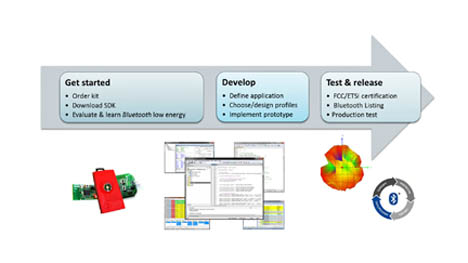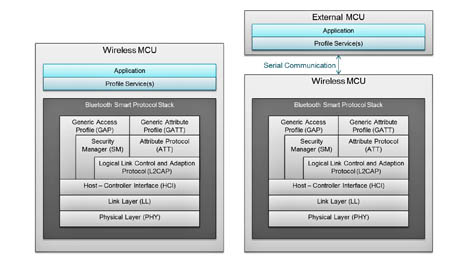Think about all the home appliances you have in your house or apartment. How would it be if you could interact wirelessly with any of the electronics in your home? Wouldn’t it be nice if your smartphone notifies you when the washing machine is done? Or how about controlling all the lighting from your smartphone? If you could add smartphone connectivity to any product in an easy and safe manner, would you do it?
Bluetooth Smart is the trending technology that gives you beacons, IoT, and cloud services. You see the information everywhere, but what is Bluetooth Smart, and how do you implement it?
Bluetooth Smart
There are multiple reasons why Bluetooth Smart is successful in plenty of market segments, including industrial, consumer, medical and automotive, and here are some key drivers for Bluetooth Smart that make it more interesting than other wireless protocols.
Bluetooth low energy is the technology used in a Bluetooth Smart product, and became part of the Bluetooth v4.0 specification in 2010. A Bluetooth low energy device operates in sleep mode most of the time and only wakes up briefly to transmit information. The average power consumption is minimized and can result in several years of battery life on single coin cell. A typical Bluetooth low energy application can be connected by using less than a couple of microamperes, on average, because it does not transmit or receive often.
Another growth driver is related to smartphones. Most smartphones on the market are already Bluetooth Smart Ready. Compared to Bluetooth classic, Bluetooth Smart is faster and simpler, and the customization factor is endless. Bluetooth Smart allows anything to be controlled from a smartphone, from advanced home automation systems to personal healthcare products and wearables, in an easy and robust way. The smartphones can also push firmware updates over the air (OTA).
Lastly, Bluetooth Smart is cost friendly, for several reasons:
- Hardware cost. Bluetooth Smart generally comes as a single-chip solution, which can be designed together with antennas and external components in an area smaller than 2 cm2 .
- Development cost. Bluetooth Smart is easy to develop with. Given the right set of tools, sample applications, and documentation, the path from an idea to a prototype can be done much faster than with other wireless connectivity protocols. With flash-based solutions, debug and development can be done rapidly, giving a quick turnaround time on features.
- Release cost. When the product is ready, regulatory testing and Bluetooth Special Interest Group (SIG) (www.bluetooth.org) qualification are required. The Bluetooth Smart protocol stack, included with the hardware solution, is typically prequalified by the software development kit (SDK) provider. The Bluetooth Smart protocol stack also includes direct test mode (DTM) that can be used for regulatory testing, and production test.
Development
Getting started with Bluetooth Smart is fairly easy (see Fig. 1 ). The first step is to order an evaluation kit, which will come with a complete SDK and provide sample applications.

Fig. 1: The Bluetooth Smart development process.
Hardware prototyping
Designing a PCB can be challenging when introducing wireless technology, as board components and layout has an impact on the RF performance. Bluetooth Smart operates on the 2.4-GHz ISM band and uses adaptive frequency hopping on 40 channels, with strict timing. The timing of the protocol requires a sleep clock accuracy of better than ±500 ppm. By using reference designs, the hardware prototyping is made easy and there are a lot of applications notes on design considerations from crystal and antenna selection guides to optimizing PCB layout.
There is also the option of using a Bluetooth Smart module. The module includes a wireless microcontroller and, in some cases, an integrated antenna, providing an easy way to add Bluetooth Smart connectivity to an existing design.
Software prototyping
Bluetooth Smart uses profile services with generic attribute profile (GATT) architecture. GATT describes how data is stored and exchanged between two or more devices, and the Bluetooth SIG is responsible for adopting new profiles and services for specific applications, such as heart rate sensors, blood glucose monitors, etc. The GATT architecture also allows custom profiles and services to be implemented, so products are not required to use the Bluetooth SIG-adopted profiles and services.
Profiles describe the use cases between devices and their relationship. They also include one or a set of services that defines the data handling. For example, heart rate profile uses a heart rate service and also a device information service. Services are merely the definitions of data set along with format and permissions.
Before the software development starts, the application use case is defined, and suitable Bluetooth SIG-adopted services can be chosen. If no profile service suits the end-product user scenario, a custom service can be created. There are several development environments for Bluetooth Smart; some provide an easy step-by-step tool that generates the required code and others include access to source. Either way, development occurs on top of a qualified Bluetooth Smart protocol stack, on the application layer, together with profile services. In some cases it can be useful to implement the application and profile services on an external device, as seen in Fig. 2 . One example is in medical systems where special requirements apply to sensor processing. In that case, the requirements would only apply to the external MCU and not the wireless MCU. Another reason might be that higher performance or more flash space is required than provided by the wireless MCU.

Fig. 2: Choices in Bluetooth processor implementation.
Qualified adopted Bluetooth SIG services, custom services, and full software examples are the keys for simplified development. It does not matter how good the hardware platform is; each need a robust, proven, and versatile software development kit.
Test and release
When hardware and software prototyping is complete, it is time for test and release. Every product that is to be released containing radio electronics needs to comply with a set of radio regulations. There are different standards depending on which region the product is targeted. US is regulated by FCC, Europe is regulated by ETSI etc.
 Fig. 3: The Bluetooth Smart logo.
Fig. 3: The Bluetooth Smart logo.
A Bluetooth listing is also required. If the qualification has been made by the wireless MCU vendor beforehand, this process is significantly simpler, faster and cheaper. The requirements are then limited to purchasing a declaration ID and then refer to the premade qualification. The listing allows the use of Bluetooth Smart logo (see Fig. 3 ).
Advertisement
Learn more about Texas Instruments





